Global economic trends are shaping the future of markets, businesses, and everyday life. From shifting trade dynamics and technological breakthroughs to demographic transformations and the growing emphasis on sustainability. These trends influence economic policies, corporate strategies, and individual decisions. Understanding these developments is crucial for anyone looking to navigate the complexities of the global economy effectively.
Shifts in Global Trade Dynamics
Recent shifts in global trade dynamics are a pivotal aspect of current global economic trends. They reflect changes in geopolitical relations and national policies. Trade policies and tariff structures have notably oscillated. This was influenced by political shifts and economic priorities in major economies like the USA, China, and the European Union. For instance, the imposition of new tariffs has sometimes escalated into trade disputes. This affects not only bilateral relations but also global supply chains and pricing structures.
Additionally, the ratification of new trade agreements has played a crucial role in shaping economic interactions. These agreements often attempt to reduce barriers to trade. They also enhance intellectual property protections, and open up new markets for goods and services. As countries adapt to these changes, industries have experienced shifts in production costs and market access. This influences global investment flows and economic stability.
Moreover, the impact of these trade dynamics extends beyond immediate economic metrics, affecting labor markets and consumer prices worldwide. As such, understanding these changes is essential for businesses and policymakers looking to navigate the complexities of international trade and leverage opportunities for growth in a rapidly evolving global marketplace.
Technological Advancements and Their Economic Impact
Technological advancements are significantly influencing global economic trends. Innovations such as artificial intelligence (AI), blockchain, and renewable energy technologies at the forefront. AI is reshaping industries by optimizing operations, enhancing customer service, and facilitating data-driven decision-making. For instance, AI-driven analytics are now critical in sectors like finance, healthcare, and retail. It provides insights that streamline processes and improve efficiency.
Similarly, blockchain technology is revolutionizing the way businesses handle data security and transactions. Its ability to provide transparent, tamper-proof systems is particularly transformative in finance, supply chain management, and intellectual property rights management. This has led to more secure and efficient business operations globally, reducing costs and enhancing trust in digital transactions.
Moreover, the shift towards renewable energy technologies is altering traditional economic models, especially in the energy sector. The increasing adoption of solar, wind, and other renewable sources is not only mitigating environmental impacts but also creating new job opportunities and reducing dependence on imported fuels.
Together, these technological shifts are creating a new economic landscape, where digital and environmental innovations drive growth and sustainability. Understanding and adapting to these changes is crucial for businesses and economies trying to stay competitive in an increasingly interconnected and technologically advanced global market.
Demographic Changes and Economic Implications
Demographic changes significantly influence global economic trends. Especially because of the contrasting scenarios of aging populations in developed countries and youth bulges in developing regions. In developed nations, aging populations are leading to higher healthcare and pension costs, creating fiscal pressures on public budgets. This demographic shift also impacts labor markets. As a larger proportion of the population retires, it may lead to labor shortages and increased dependence on technology.
Conversely, in developing countries, large youth populations present both challenges and opportunities. While this demographic trend offers a potential demographic dividend, it also requires substantial investment in education and job creation. This will prevent economic stagnation and social unrest. Successful harnessing of this youthful workforce can drive consumption, as younger people tend to have higher spending rates on technology, education, and consumer goods.
Furthermore, these demographic shifts affect global consumption patterns. Aging populations may lead to increased spending in healthcare and wellness sectors, whereas youthful demographics boost demand in sectors like digital technology and education. Each trend requires distinct economic strategies to optimize growth and stability, reflecting the complex interplay between demographic dynamics and economic outcomes in shaping the future of global economies.
Sustainability and Green Economy Trends
The rise of the green economy is a pivotal aspect of current global economic trends, driven by increasing awareness of environmental sustainability and the economic benefits of renewable energy sources. Investments in sustainable practices are escalating, with both private and public sectors committing substantial funds towards greener technologies. This shift not only helps reduce carbon footprints but also creates new industries and job opportunities, stimulating economic growth.
Furthermore, the transition towards renewable energy sources such as solar, wind, and hydro is significantly impacting traditional energy markets. This shift is reducing dependence on fossil fuels, thereby altering global energy politics and economics. Moreover, the cost of renewable technologies has decreased dramatically, making them more competitive with conventional energy sources and more accessible to a broader range of economies.
Additionally, sustainable business practices are increasingly becoming a criterion for investment decisions. Companies adopting eco-friendly methods are often seen as more innovative and less risky, attracting investors looking for sustainable investment opportunities. This trend is fostering a new market dynamic where environmental considerations are integral to economic strategies.
Embracing these green economy trends not only helps mitigate environmental impact but also propels economic innovation, offering a pathway to sustainable development that aligns ecological preservation with economic progress.
Post-Pandemic Economic Recovery Patterns
The COVID-19 pandemic has significantly influenced global economic trends, with varying recovery rates and strategies observed across different regions. In many developed economies, recovery has been accelerated by substantial fiscal stimulus packages, which have boosted consumer spending and supported small businesses. However, the rapid recovery in these regions contrasts with the slower rebound in many developing countries, where limited fiscal space and lower vaccination rates have prolonged economic disruptions.
Additionally, the adoption of digital technologies has emerged as a key strategy in economic recovery. Economies that swiftly embraced digital transformation have seen a faster return to pre-pandemic levels of activity, particularly in sectors like retail, education, and telecommunication. This digital shift has not only supported business continuity during lockdowns but also spurred innovation across various industries.
Moreover, the pandemic has highlighted the importance of resilient supply chains. Countries and companies that have diversified their supply chains or invested in domestic production capacities are experiencing less disruption and faster recovery. This reconfiguration of supply chains is becoming a significant part of the strategic planning for future resilience.
Despite these successes, ongoing challenges remain. The uneven pace of vaccine distribution continues to pose a risk to global economic stability, with potential setbacks from new virus variants. Additionally, rising debt levels, especially in emerging markets, threaten sustainable economic growth. Addressing these issues is crucial as countries navigate the complex landscape of post-pandemic recovery, aiming to build economies that are not only resilient but also inclusive and sustainable.
Conclusion
In conclusion, understanding global economic trends is essential for navigating the complexities of today’s interconnected world. From shifts in trade policies to technological advancements, demographic changes, sustainability efforts, and post-pandemic recovery patterns, each trend offers unique challenges and opportunities. Policymakers, businesses, and individuals must stay informed and adaptable to leverage these trends effectively. As the global economy continues to evolve, being proactive in response to these changes will be crucial for fostering sustainable growth and resilience in the face of future economic fluctuations. This comprehensive approach will not only mitigate potential risks but also capitalize on the opportunities that arise from the dynamic global economic landscape.


